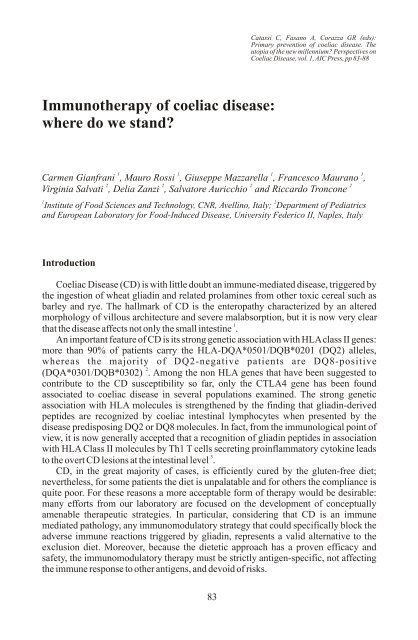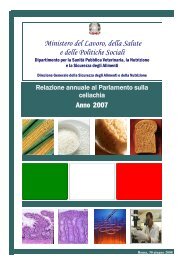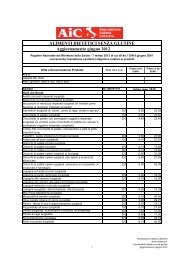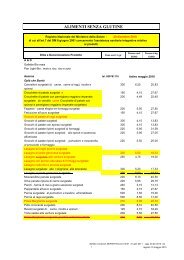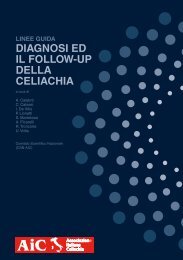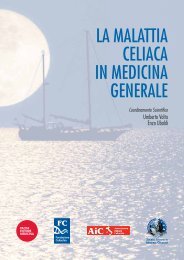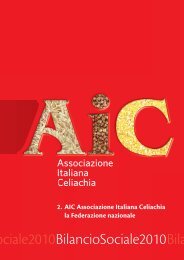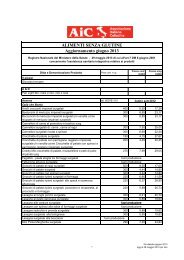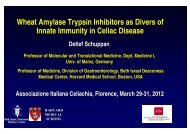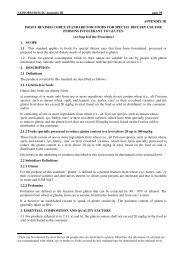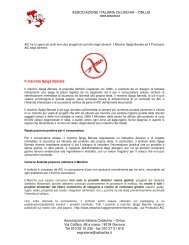primary prevention of coeliac disease - Associazione Italiana ...
primary prevention of coeliac disease - Associazione Italiana ...
primary prevention of coeliac disease - Associazione Italiana ...
You also want an ePaper? Increase the reach of your titles
YUMPU automatically turns print PDFs into web optimized ePapers that Google loves.
Catassi C, Fasano A, Corazza GR (eds):<br />
Primary <strong>prevention</strong> <strong>of</strong> <strong>coeliac</strong> <strong>disease</strong>. The<br />
utopia <strong>of</strong> the new millennium? Perspectives on<br />
Coeliac Disease, vol. 1, AIC Press, pp 83-88<br />
Immunotherapy <strong>of</strong> <strong>coeliac</strong> <strong>disease</strong>:<br />
where do we stand?<br />
1 1 1 1<br />
Carmen Gianfrani , Mauro Rossi , Giuseppe Mazzarella , Francesco Maurano ,<br />
2 2 2 2<br />
Virginia Salvati , Delia Zanzi , Salvatore Auricchio and Riccardo Troncone<br />
1 2<br />
Institute <strong>of</strong> Food Sciences and Technology, CNR, Avellino, Italy; Department <strong>of</strong> Pediatrics<br />
and European Laboratory for Food-Induced Disease, University Federico II, Naples, Italy<br />
Introduction<br />
Coeliac Disease (CD) is with little doubt an immune-mediated <strong>disease</strong>, triggered by<br />
the ingestion <strong>of</strong> wheat gliadin and related prolamines from other toxic cereal such as<br />
barley and rye. The hallmark <strong>of</strong> CD is the enteropathy characterized by an altered<br />
morphology <strong>of</strong> villous architecture and severe malabsorption, but it is now very clear<br />
1<br />
that the <strong>disease</strong> affects not only the small intestine .<br />
An important feature <strong>of</strong> CD is its strong genetic association with HLA class II genes:<br />
more than 90% <strong>of</strong> patients carry the HLA-DQA*0501/DQB*0201 (DQ2) alleles,<br />
whereas the majority <strong>of</strong> DQ2-negative patients are DQ8-positive<br />
2<br />
(DQA*0301/DQB*0302) . Among the non HLA genes that have been suggested to<br />
contribute to the CD susceptibility so far, only the CTLA4 gene has been found<br />
associated to <strong>coeliac</strong> <strong>disease</strong> in several populations examined. The strong genetic<br />
association with HLA molecules is strengthened by the finding that gliadin-derived<br />
peptides are recognized by <strong>coeliac</strong> intestinal lymphocytes when presented by the<br />
<strong>disease</strong> predisposing DQ2 or DQ8 molecules. In fact, from the immunological point <strong>of</strong><br />
view, it is now generally accepted that a recognition <strong>of</strong> gliadin peptides in association<br />
with HLA Class II molecules by Th1 T cells secreting proinflammatory cytokine leads<br />
3<br />
to the overt CD lesions at the intestinal level .<br />
CD, in the great majority <strong>of</strong> cases, is efficiently cured by the gluten-free diet;<br />
nevertheless, for some patients the diet is unpalatable and for others the compliance is<br />
quite poor. For these reasons a more acceptable form <strong>of</strong> therapy would be desirable:<br />
many efforts from our laboratory are focused on the development <strong>of</strong> conceptually<br />
amenable therapeutic strategies. In particular, considering that CD is an immune<br />
mediated pathology, any immunomodulatory strategy that could specifically block the<br />
adverse immune reactions triggered by gliadin, represents a valid alternative to the<br />
exclusion diet. Moreover, because the dietetic approach has a proven efficacy and<br />
safety, the immunomodulatory therapy must be strictly antigen-specific, not affecting<br />
the immune response to other antigens, and devoid <strong>of</strong> risks.<br />
83


